Adaptation of a Neuro-Variational Algorithm from SeaWiFS to MODIS-Aqua Sensor for the Determination of Atmospheric and Oceanic Variables
Abstract
1. Introduction
2. Material and Methods
2.1. MODIS-Aqua Standard Data
2.2. SOM-NV Processing of MODIS-Aqua Data
2.2.1. Algorithm Description
2.2.2. Adaptation to MODIS Data
- The 510 nm band used by SOM-A-S (finding no equivalent on MODIS sensor) is replaced by the 531 nm during the projection of the image;
- The 765 nm wavelength column of SeaWIFS is replaced by a null vector;
- values are taken from the version 7.5 of SeaDAS software to remain in the same standard as SeaWiFS.
2.2.3. Coverage Calculation
2.2.4. In Situ Data
AERONET Data
HPLC Data
Multispectral Fluorometer Data (FluoroProbe)
3. Results
3.1. Aerosol Optical Thickness Derived from the SOM-NV Algorithm
3.2. Improved Data Coverage
3.3. Improving Reflectance Spectra
3.4. Consequences on Chla Estimates
Validation of Chla Estimated by SOM-NV
4. Discussion
5. Conclusions
Author Contributions
Funding
Data Availability Statement
Acknowledgments
Conflicts of Interest
Appendix A
Appendix A.1. Coverage Pattern
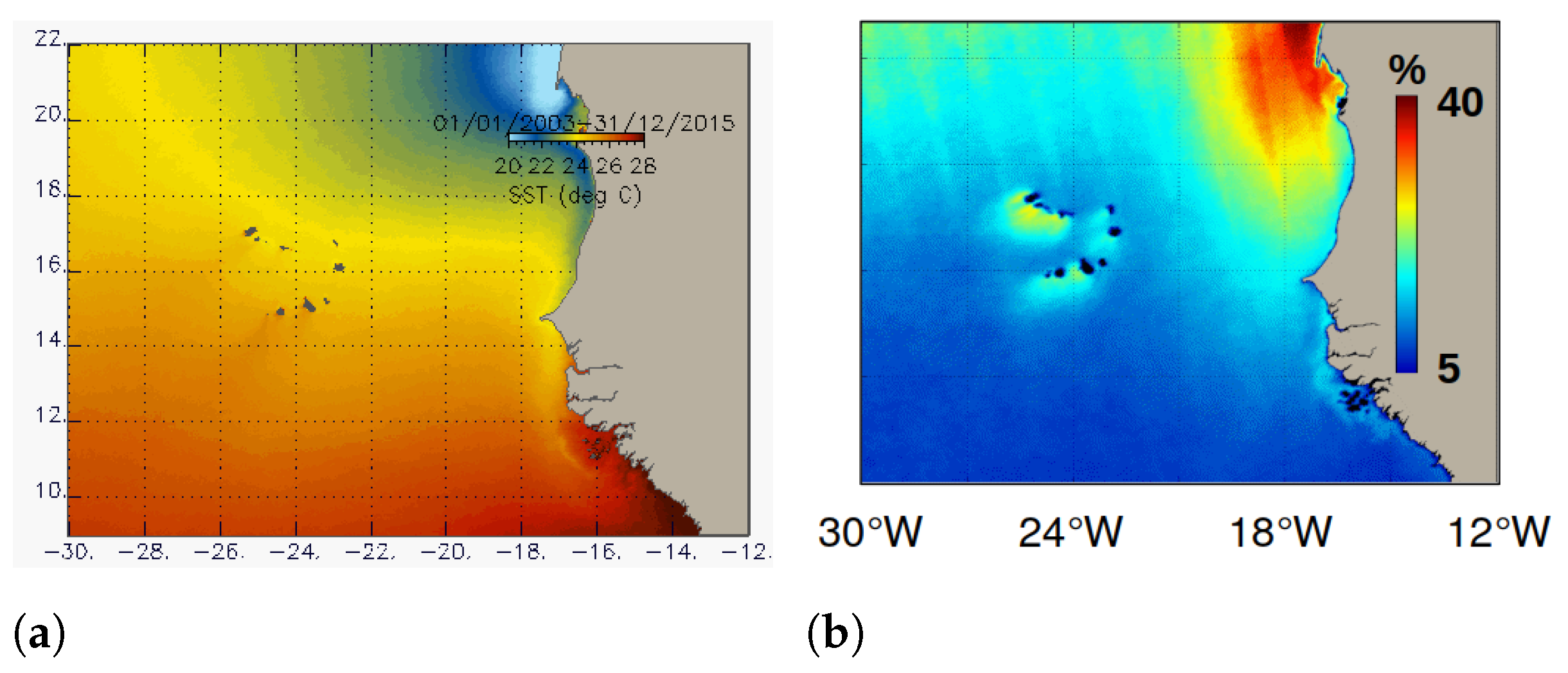
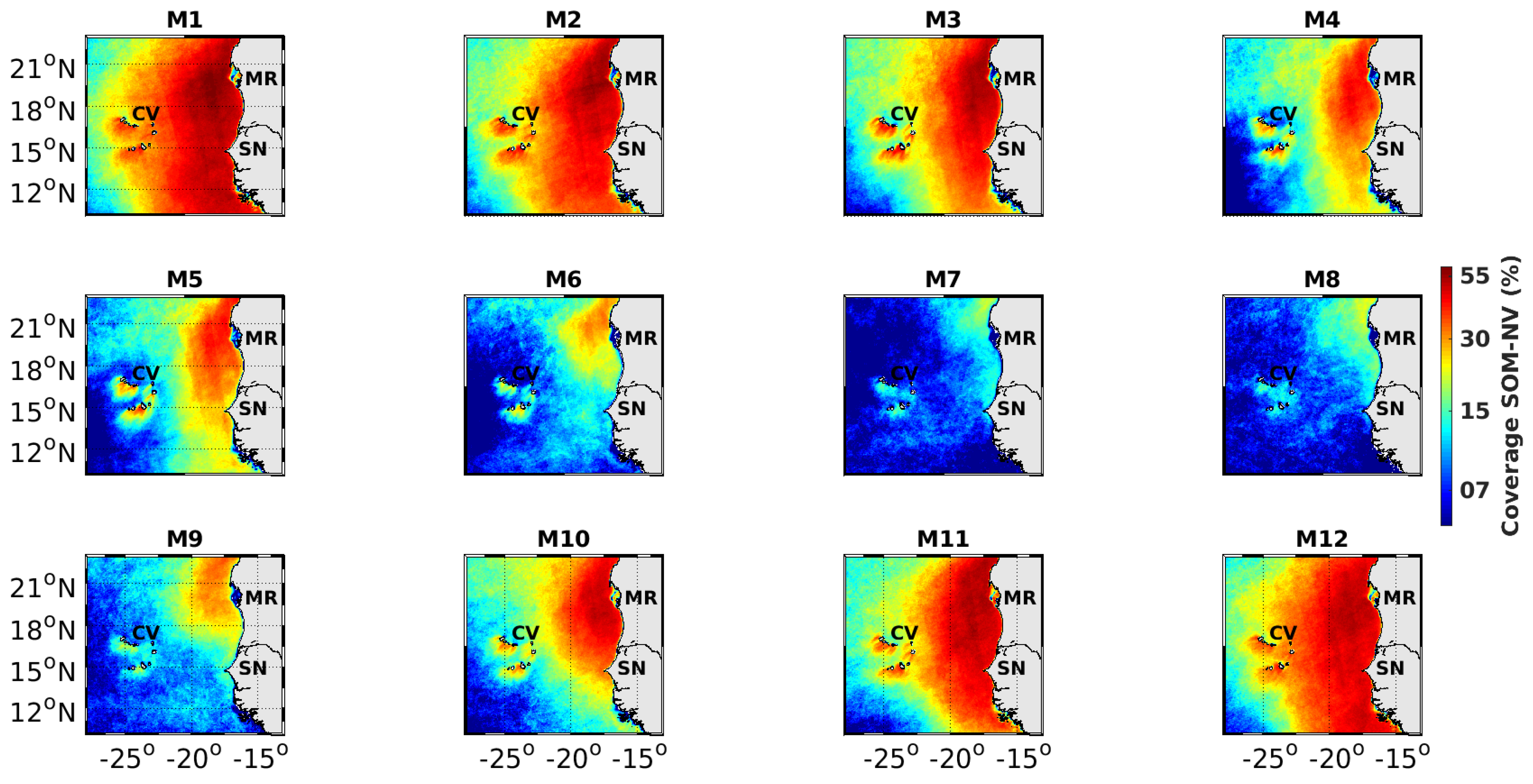
Appendix A.2. Chla Validation
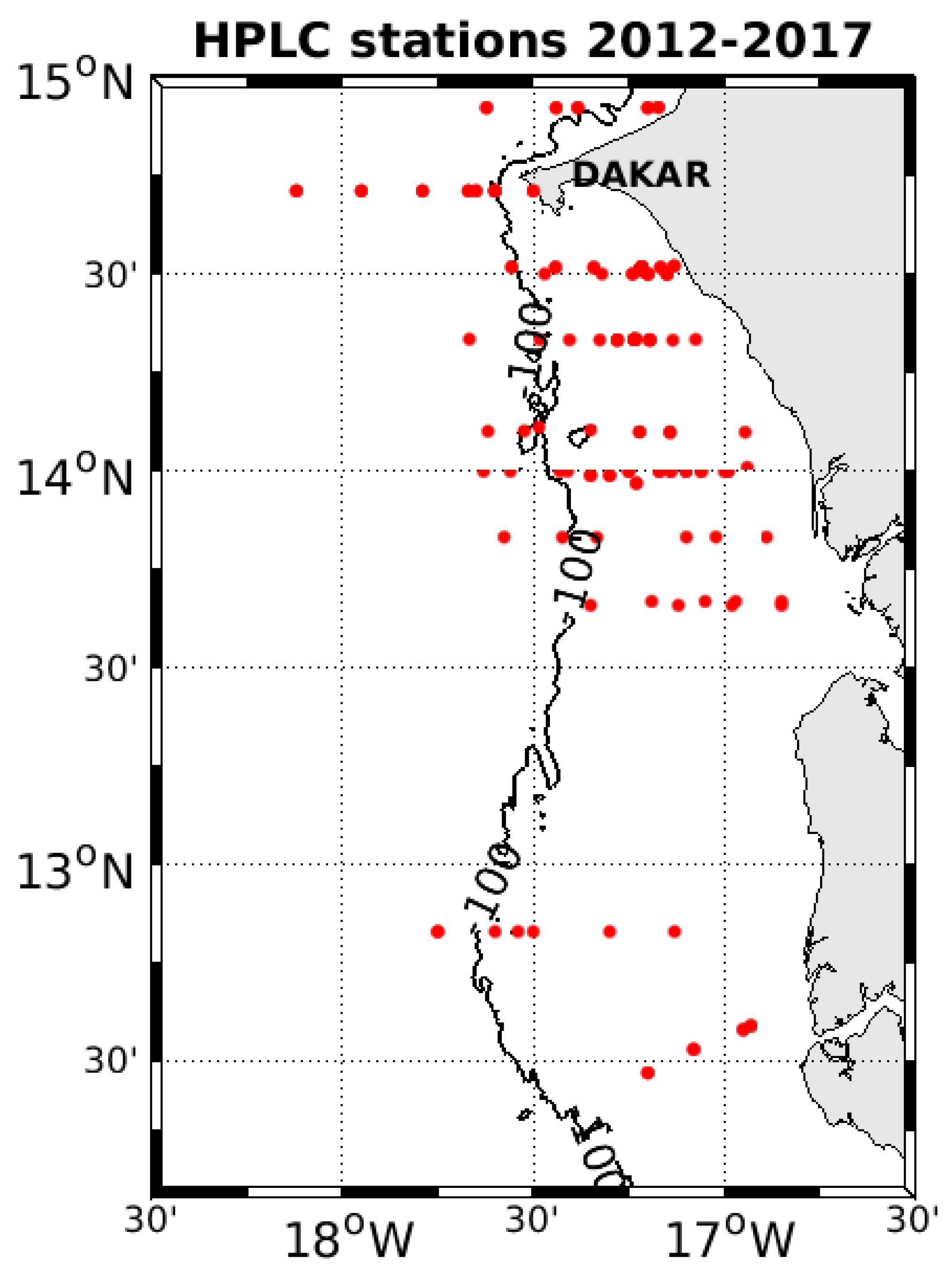


Appendix A.3. HPLC vs. FP Regression
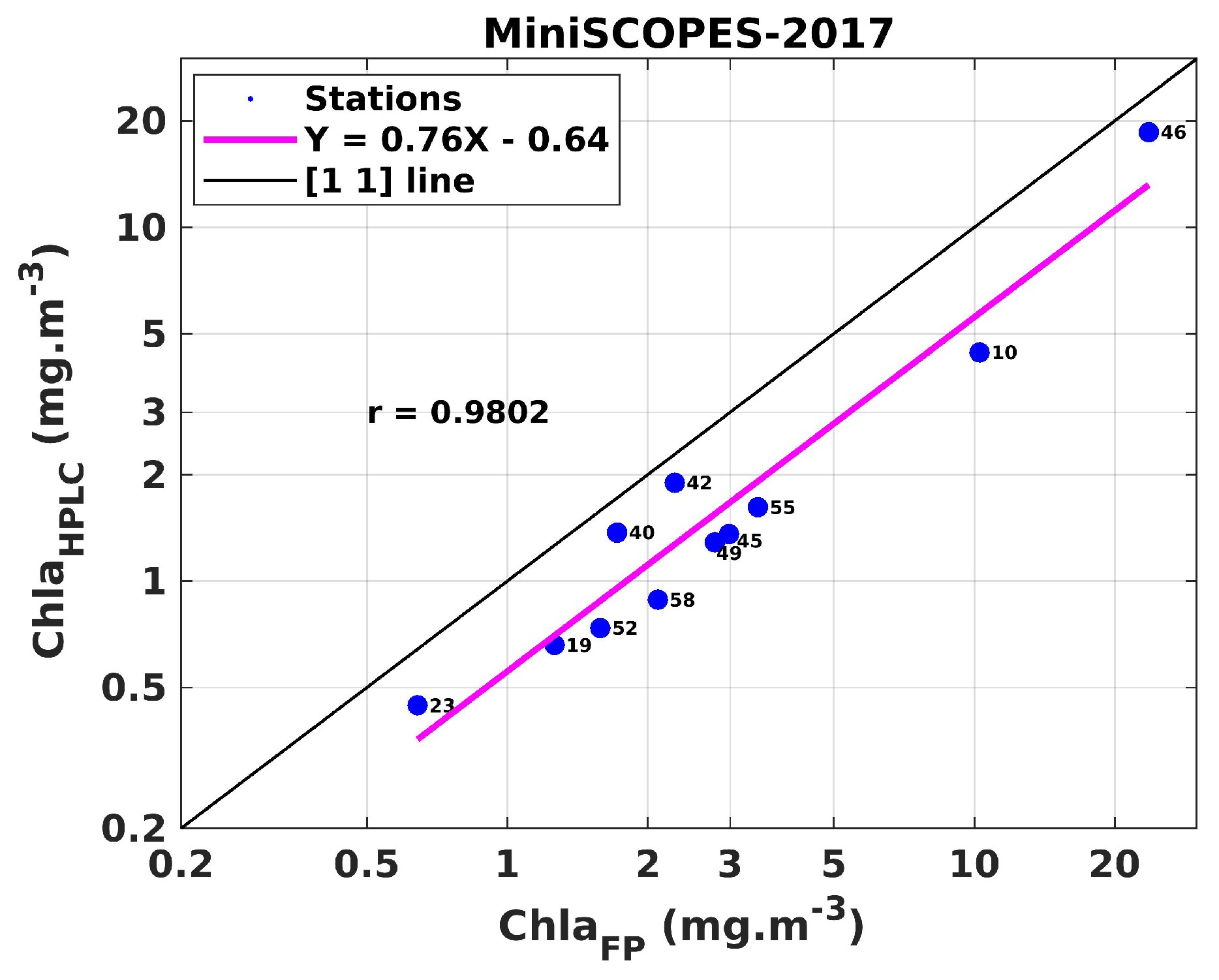
References
- Hovis, W.; Clark, D.; Anderson, F.; Austin, R.; Wilson, W.; Baker, E.; Ball, D.; Gordon, H.; Mueller, J.; El-Sayed, S.; et al. Nimbus-7 Coastal Zone Color Scanner: System description and initial imagery. Science 1980, 210, 60–63. [Google Scholar] [CrossRef] [PubMed]
- Franz, B.; Werdell, P.; Meister, G.; Bailey, S.; Eplee, R., Jr.; Feldman, G.; Kwiatkowska, E.; McClain, C.; Patt, F.; Thomas, D. The continuity of ocean color measurements from SeaWiFS to MODIS. Earth Obs. Syst. X 2005, 5882, 58820W. [Google Scholar]
- Clarke, G.; Ewing, G.; Lorenzen, C. Spectra of backscattered light from the sea obtained from aircraft as a measure of chlorophyll concentration. Science 1970, 167, 1119–1121. [Google Scholar] [CrossRef]
- Wang, M.; Son, S.; Shi, W. Evaluation of MODIS SWIR and NIR-SWIR atmospheric correction algorithms using SeaBASS data. Remote Sens. Environ. 2009, 113, 635–644. [Google Scholar] [CrossRef]
- Mobley, C. Others the Oceanic Optics Book; International Ocean Colour Coordinating Group (IOCCG): Dartmouth, NS, Canada, 2022. [Google Scholar] [CrossRef]
- Ogunjobi, K.; Kim, Y.; He, Z. Aerosol optical properties during Asian dust storm episodes in South Korea. Theor. Appl. Climatol. 2003, 76, 65–75. [Google Scholar] [CrossRef]
- Andreae, M. Raising dust in the greenhouse. Nature 1996, 380, 389–390. [Google Scholar] [CrossRef]
- Solomon, S.; Qin, D.; Manning, M.; Averyt, K.; Marquis, M. Climate Change 2007—The Physical Science Basis: Working Group I Contribution to the Fourth Assessment Report of the IPCC; Cambridge University Press: Cambridge, UK, 2007. [Google Scholar]
- Tanaka, T.; Kurosaki, Y.; Chiba, M.; Matsumura, T.; Nagai, T.; Yamazaki, A.; Uchiyama, A.; Tsunematsu, N.; Kai, K. Possible transcontinental dust transport from North Africa and the Middle East to East Asia. Atmos. Environ. 2005, 39, 3901–3909. [Google Scholar] [CrossRef]
- Ganor, E.; Osetinsky, I.; Stupp, A.; Alpert, P. Increasing trend of African dust, over 49 years, in the eastern Mediterranean. J. Geophys. Res. Atmos. 2010, 115. [Google Scholar] [CrossRef]
- Ansmann, A.; Baars, H.; Tesche, M.; Müller, D.; Althausen, D.; Engelmann, R.; Pauliquevis, T.; Artaxo, P. Dust and smoke transport from Africa to South America: Lidar profiling over Cape Verde and the Amazon rainforest. Geophys. Res. Lett. 2009, 36. [Google Scholar] [CrossRef]
- Prospero, J.; Glaccum, R.; Nees, R. Atmospheric transport of soil dust from Africa to South America. Nature 1981, 289, 570–572. [Google Scholar] [CrossRef]
- Senghor, H.; Machu, É.; Durán, L.; Jenkins, G.; Gaye, A. Seasonal behavior of aerosol vertical concentration in Dakar and role played by the sea-breeze. Open J. Air Pollut. 2020, 9, 11–26. [Google Scholar] [CrossRef]
- Senghor, H.; Machu, É.; Hourdin, F.; Gaye, A. Seasonal cycle of desert aerosols in western Africa: Analysis of the coastal transition with passive and active sensors. Atmos. Chem. Phys. 2017, 17, 8395–8410. [Google Scholar] [CrossRef]
- Song, L.; Bi, X.; Zhang, Z.; Li, L.; Dai, Q.; Zhang, W.; Li, H.; Wang, X.; Liang, D.; Feng, Y. Impact of sand and dust storms on the atmospheric environment and its source in Tianjin-China. Sci. Total. Environ. 2022, 825, 153980. [Google Scholar] [CrossRef] [PubMed]
- Gordon, H.; Wang, M. Retrieval of water-leaving radiance and aerosol optical thickness over the oceans with SeaWiFS: A preliminary algorithm. Appl. Opt. 1994, 33, 443–452. [Google Scholar] [CrossRef]
- IOCCG. IOCCG Atmospheric Correction for Remotely-Sensed Ocean-Colour Products. 2010. Available online: http://www.ioccg.org/reports/report10.pdf (accessed on 20 June 2023).
- Mobley, C.; Werdell, J.; Franz, B.; Ahmad, Z.; Bailey, S. Atmospheric Correction for Satellite Ocean Color Radiometry; National Aeronautics: No. GSFC-E-DAA-TN35509; 2016. Available online: https://ntrs.nasa.gov/api/citations/20160011399/downloads/20160011399.pdf (accessed on 20 June 2023).
- Ahmad, Z.; Franz, B.; McClain, C.; Kwiatkowska, E.; Werdell, J.; Shettle, E.; Holben, B. New aerosol models for the retrieval of aerosol optical thickness and normalized water-leaving radiances from the SeaWiFS and MODIS sensors over coastal regions and open oceans. Appl. Opt. 2010, 49, 5545–5560. [Google Scholar] [CrossRef]
- Hassan, N.; Woo, C. Machine learning application in water quality using satellite data. In IOP Conference Series: Earth Furthermore, Environmental Science; IOP Publishing: Bristol, UK, 2021; Volume 842, p. 012018. [Google Scholar]
- Brajard, J.; Moulin, C.; Thiria, S. Atmospheric correction of SeaWiFS ocean color imagery in the presence of absorbing aerosols off the Indian coast using a neuro-variational method. Geophys. Res. Lett. 2008, 35. [Google Scholar] [CrossRef]
- Brajard, J.; Jamet, C.; Moulin, C.; Thiria, S. Use of a neuro-variational inversion for retrieving oceanic and atmospheric constituents from satellite ocean colour sensor: Application to absorbing aerosols. Neural Netw. 2006, 19, 178–185. [Google Scholar] [CrossRef]
- Niang, A.; Badran, F.; Moulin, C.; Crépon, M.; Thiria, S. Retrieval of aerosol type and optical thickness over the Mediterranean from SeaWiFS images using an automatic neural classification method. Remote Sens. Environ. 2006, 100, 82–94. [Google Scholar] [CrossRef]
- Thiria, S.; Badran, F.; Sorror, C. YAO: Un Logiciel pour les Modèles Numériques et l’assimilation de Données (Schéma Direct Adjoint et Assimilation Variationnelle); LOCEAN: Paris, France, 2006. [Google Scholar]
- Moulin, C.; Gordon, H.; Chomko, R.; Banzon, V.; Evans, R. Atmospheric correction of ocean color imagery through thick layers of Saharan dust. Geophys. Res. Lett. 2001, 28, 5–8. [Google Scholar] [CrossRef]
- Diouf, D.; Niang, A.; Brajard, J.; Crépon, M.; Thiria, S. Retrieving aerosol characteristics and sea-surface chlorophyll from satellite ocean color multi-spectral sensors using a neural-variational method. Remote Sens. Environ. 2013, 130, 74–86. [Google Scholar] [CrossRef]
- Esaias, W.; Abbott, M.; Barton, I.; Brown, O.; Campbell, J.; Carder, K.; Clark, D.; Evans, R.; Hoge, F.; Gordon, H.; et al. Others An overview of MODIS capabilities for ocean science observations. IEEE Trans. Geosci. Remote Sens. 1998, 36, 1250–1265. [Google Scholar] [CrossRef]
- Franz, B.; Bailey, S.; Werdell, P.; McClain, C. Sensor-independent approach to the vicarious calibration of satellite ocean color radiometry. Appl. Opt. 2007, 46, 5068–5082. [Google Scholar] [CrossRef] [PubMed]
- Bailey, S.; Franz, B.; Werdell, P. Estimation of near-infrared water-leaving reflectance for satellite ocean color data processing. Opt. Express 2010, 18, 7521–7527. [Google Scholar] [CrossRef]
- Yang, H.; Gordon, H. Remote sensing of ocean color: Assessment of water-leaving radiance bidirectional effects on atmospheric diffuse transmittance. Appl. Opt. 1997, 36, 7887–7897. [Google Scholar] [CrossRef]
- Wang, M. The Rayleigh lookup tables for the SeaWiFS data processing: Accounting for the effects of ocean surface roughness. Int. J. Remote Sens. 2002, 23, 2693–2702. [Google Scholar] [CrossRef]
- Wang, M.; Bailey, S. Correction of sun glint contamination on the SeaWiFS ocean and atmosphere products. Appl. Opt. 2001, 40, 4790–4798. [Google Scholar] [CrossRef] [PubMed]
- Gordon, H.; Wang, M. Influence of oceanic whitecaps on atmospheric correction of ocean-color sensors. Appl. Opt. 1994, 33, 7754–7763. [Google Scholar] [CrossRef] [PubMed]
- Kohonen, T.; Kohonen, T. The basic SOM. Self-Organizing Maps; Springer: Berlin/Heidelberg, Germany, 2001; pp. 105–176. [Google Scholar]
- Brajard, J.; Niang, A.; Sawadogo, S.; Fell, F.; Santer, R.; Thiria, S. Estimating aerosol parameters above the ocean from MERIS observations using topological maps. Int. J. Remote. Sens. 2007, 28, 781–795. [Google Scholar] [CrossRef]
- Jamet, C.; Thiria, S.; Moulin, C.; Crépon, M. Use of a neurovariational inversion for retrieving oceanic and atmospheric constituents from ocean color imagery: A feasibility study. J. Atmos. Ocean. Technol. 2005, 22, 460–475. [Google Scholar] [CrossRef]
- Moulin, C.; Gordon, H.; Banzon, V.; Evans, R. Assessment of Saharan dust absorption in the visible from SeaWiFS imagery. J. Geophys. Res. Atmos. 2001, 106, 18239–18249. [Google Scholar] [CrossRef]
- Shettle, E.; Fenn, R. Models for the Aerosols of the Lower Atmosphere and the Effects of Humidity Variations on Their Optical Properties; Technical Report, Air Force Geophysics Laboratory, Air Force Systems Command, United States Air Force; Environ. Res. Paper 676, AFGL-TR-79-0214; Hanscom Air Force Base: Bedford, MA, USA, 1979. [Google Scholar]
- Chomko, R.; Gordon, H. Atmospheric correction of ocean color imagery: Use of the Junge power-law aerosol size distribution with variable refractive index to handle aerosol absorption. Appl. Opt. 1998, 37, 5560–5572. [Google Scholar] [CrossRef] [PubMed]
- Holben, B.; Eck, T.; Slutsker, I.; Tanre, D.; Buis, J.; Setzer, A.; Vermote, E.; Reagan, J.; Kaufman, Y.; Nakajima, T.; et al. Others AERONET—A federated instrument network and data archive for aerosol characterization. Remote. Sens. Environ. 1998, 66, 1–16. [Google Scholar] [CrossRef]
- Giles, D.; Sinyuk, A.; Sorokin, M.; Schafer, J.; Smirnov, A.; Slutsker, I.; Eck, T.; Holben, B.; Lewis, J.; Campbell, J.; et al. Others Advancements in the Aerosol Robotic Network (AERONET) Version 3 database–automated near-real-time quality control algorithm with improved cloud screening for Sun photometer aerosol optical depth (AOD) measurements. Atmos. Meas. Tech. 2019, 12, 169–209. [Google Scholar] [CrossRef]
- Ras, J.; Claustre, H.; Uitz, J. Spatial variability of phytoplankton pigment distributions in the Subtropical South Pacific Ocean: Comparison between in situ and predicted data. Biogeosciences 2008, 5, 353–369. [Google Scholar] [CrossRef]
- Van Heukelem, L.; Thomas, C. Computer-assisted high-performance liquid chromatography method development with applications to the isolation and analysis of phytoplankton pigments. J. Chromatogr. A 2001, 910, 31–49. [Google Scholar] [CrossRef]
- Beutler, M.; Wiltshire, K.; Meyer, B.; Moldaenke, C.; Lüring, C.; Meyerhöfer, M.; Hansen, U.; Dau, H. A fluorometric method for the differentiation of algal populations in vivo and in situ. Photosynth. Res. 2002, 72, 39–53. [Google Scholar] [CrossRef] [PubMed]
- Morel, A. Optical modeling of the upper ocean in relation to its biogenous matter content (case I waters). J. Geophys. Res. Oceans 1988, 93, 10749–10768. [Google Scholar] [CrossRef]
- Morel, A.; Maritorena, S. Bio-optical properties of oceanic waters: A reappraisal. J. Geophys. Res. Oceans 2001, 106, 7163–7180. [Google Scholar] [CrossRef]
- Pope, R.; Fry, E. Absorption spectrum (380–700 nm) of pure water. II. Integrating cavity measurements. Appl. Opt. 1997, 36, 8710–8723. [Google Scholar] [CrossRef]
- Bricaud, A.; Morel, A.; Prieur, L. Others Absorption by dissolved organic matter of the sea (yellow substance) in the UV and visible domains. Limnol. Oceanogr. 1981, 26, 43–53. [Google Scholar] [CrossRef]
- Capet, X.; Estrade, P.; Machu, E.; Ndoye, S.; Grelet, J.; Lazar, A.; Marié, L.; Dausse, D.; Brehmer, P. On the dynamics of the southern Senegal upwelling center: Observed variability from synoptic to superinertial scales. J. Phys. Oceanogr. 2017, 47, 155–180. [Google Scholar] [CrossRef]
- Alvain, S.; Moulin, C.; Dandonneau, Y.; Bréon, F. Remote sensing of phytoplankton groups in case 1 waters from global SeaWiFS imagery. Deep. Sea Res. Part I Oceanogr. Res. Pap. 2005, 52, 1989–2004. [Google Scholar] [CrossRef]
- Skonieczny, C.; McGee, D.; Winckler, G.; Bory, A.; Bradtmiller, L.; Kinsley, C.; Polissar, P.; De Pol-Holz, R.; Rossignol, L.; Malaizé, B. Monsoon-driven Saharan dust variability over the past 240,000 years. Sci. Adv. 2019, 5, eaav1887. [Google Scholar] [CrossRef] [PubMed]
- Jethva, H.; Torres, O.; Ahn, C. Global assessment of OMI aerosol single-scattering albedo using ground-based AERONET inversion. J. Geophys. Res. Atmos. 2014, 119, 9020–9040. [Google Scholar] [CrossRef]
- Horváth, Á.; Seethala, C.; Deneke, H. View angle dependence of MODIS liquid water path retrievals in warm oceanic clouds. J. Geophys. Res. Atmos. 2014, 119, 8304–8328. [Google Scholar] [CrossRef]
- Wagener, T. Le fer à l’interface océan-atmosphère: Flux et processus de dissolution dans l’eau de mer. Ph.D. Thesis, Université de la Méditerranée-Aix-Marseille II, Marseille, France, 2008. [Google Scholar]
- Ryder, C.; Highwood, E.; Lai, T.; Sodemann, H.; Marsham, J. Impact of atmospheric transport on the evolution of microphysical and optical properties of Saharan dust. Geophys. Res. Lett. 2013, 40, 2433–2438. [Google Scholar] [CrossRef]
- Shi, W.; Wang, M. Detection of turbid waters and absorbing aerosols for the MODIS ocean color data processing. Remote Sens. Environ. 2007, 110, 149–161. [Google Scholar] [CrossRef]
- Pfahl, S.; Sodemann, H. What controls deuterium excess in global precipitation? Clim. Past 2014, 10, 771–781. [Google Scholar] [CrossRef]
- Lathuilière, C.; Echevin, V.; Lévy, M. Seasonal and intraseasonal surface chlorophyll-a variability along the northwest African coast. J. Geophys. Res. Oceans 2008, 113. [Google Scholar] [CrossRef]
- Barton, E.D.; Arıstegui, J.; Tett, P.; Cantón, M.; Garcıa-Braun, J.; Hernández-León, S.; Nykjaer, L.; Almeida, C.; Almunia, J.; Ballesteros, S.; et al. Others The transition zone of the Canary Current upwelling region. Prog. Oceanogr. 1998, 41, 455–504. [Google Scholar] [CrossRef]
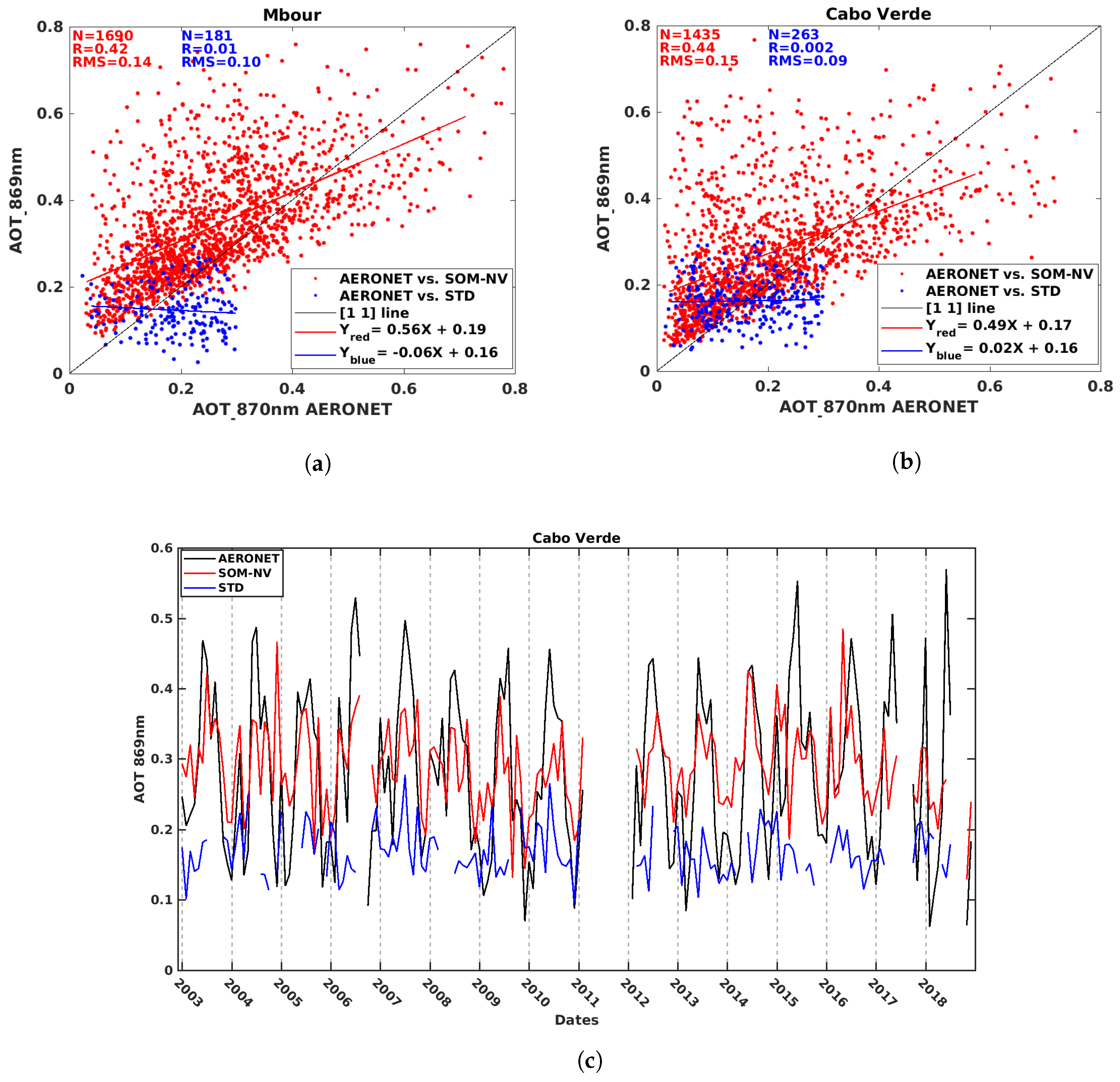



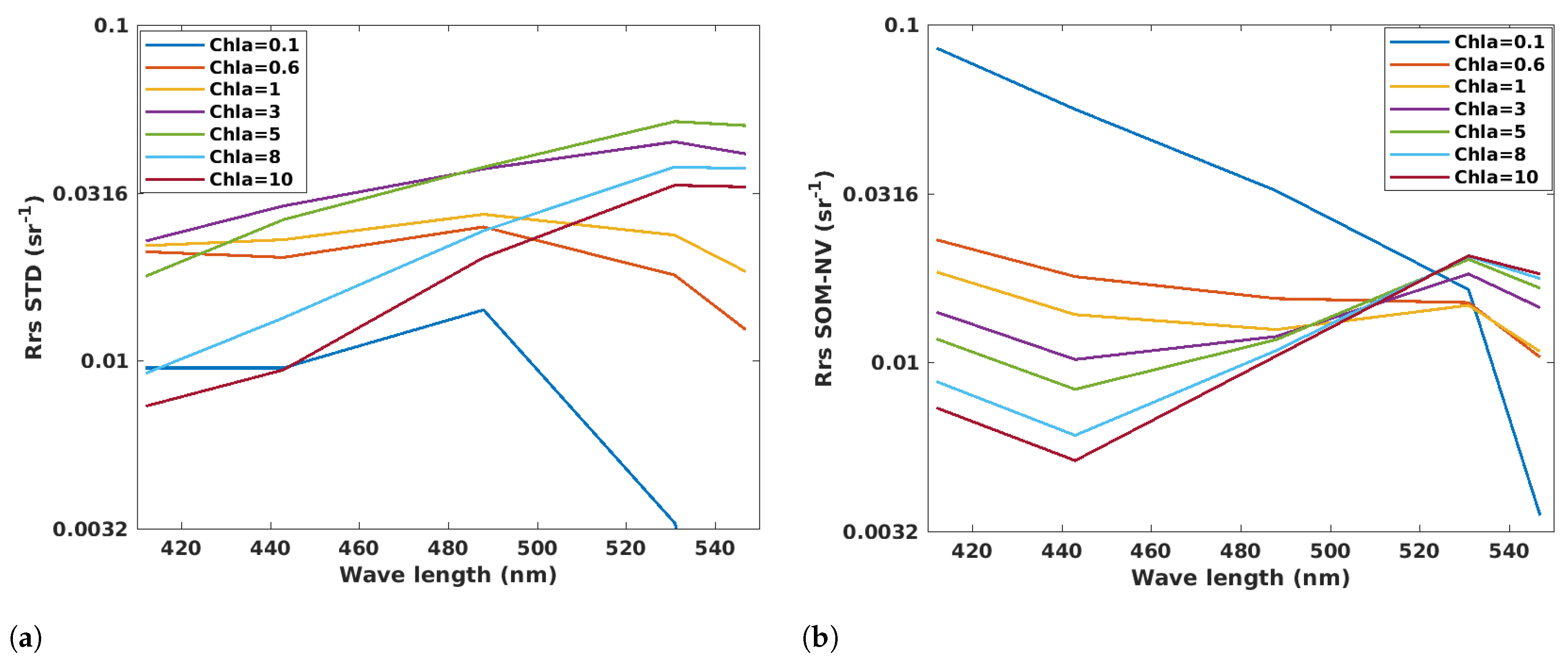
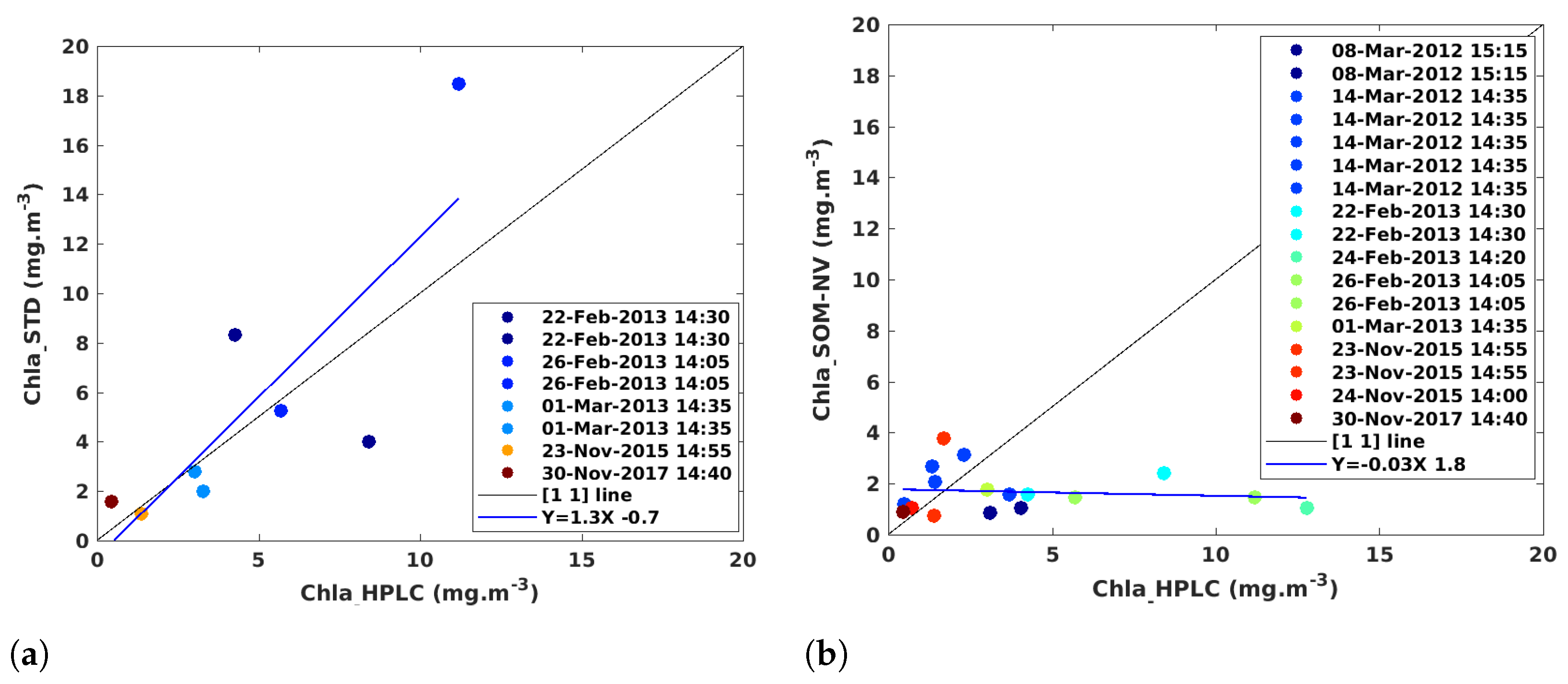

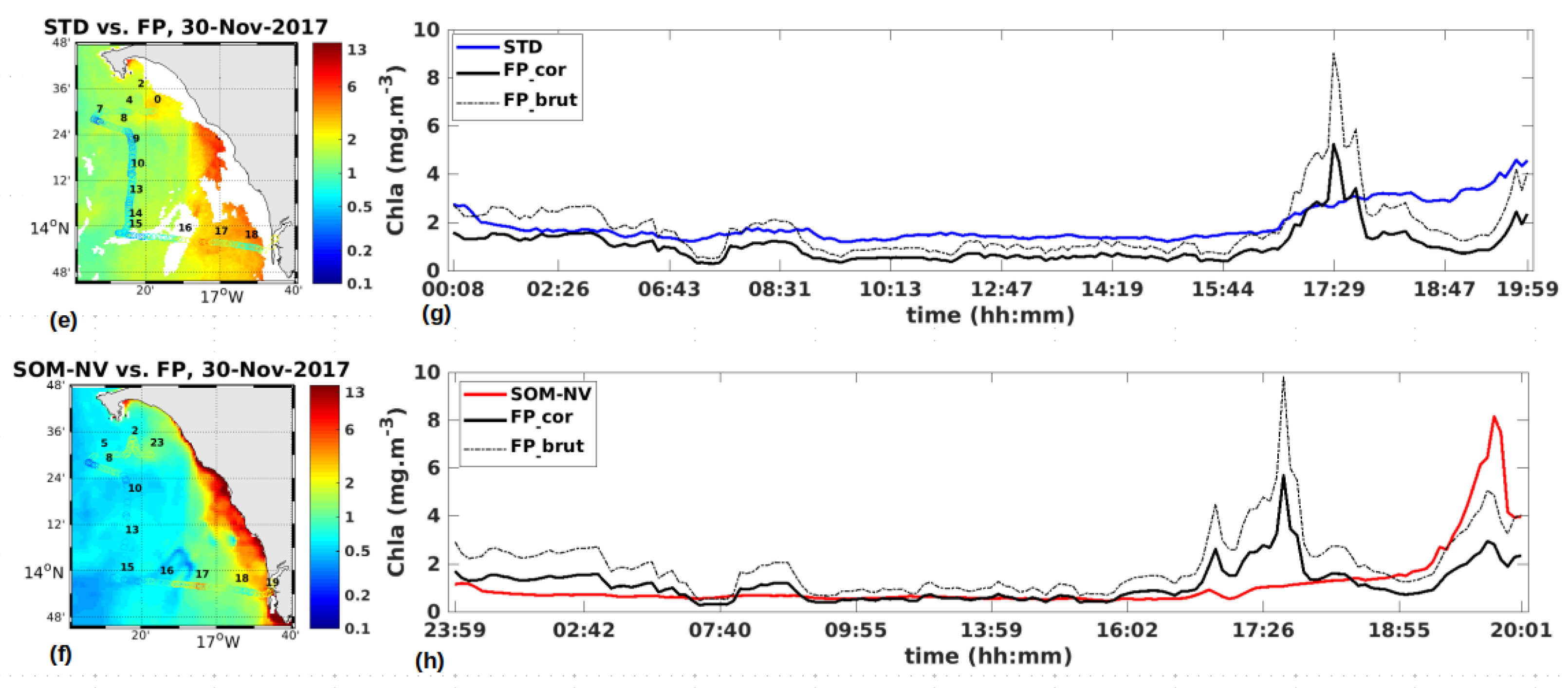
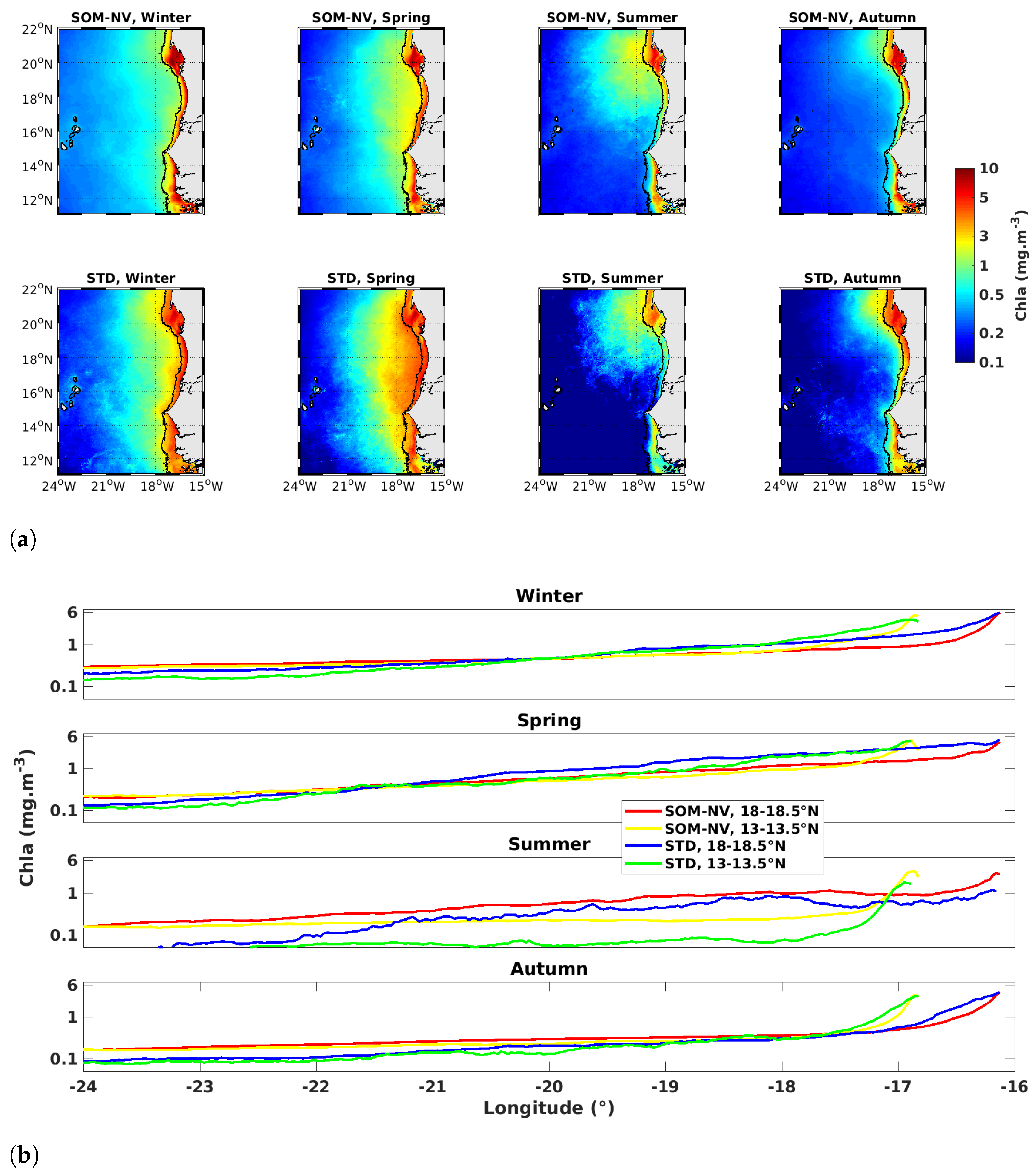
| SeaWiFS Band Number | SeaWiFS Wavelength | MODIS Band Number | MODIS Center Band |
|---|---|---|---|
| 1 | 412 | 8 | 412 |
| 2 | 443 | 9 | 443 |
| 3 | 490 | 10 | 488 |
| 4 | 510 | 11 | 531 |
| 5 | 555 | 12 | 547 |
| 7 | 765 | 15 | 748 |
| 8 | 865 | 16 | 869 |
| Autumn | Winter | Spring | Summer | |
|---|---|---|---|---|
| SOM-NV corr. | 0.53 | 0.68 | 0.37 | 0.43 |
| p-value | <0.05 | <0.05 | <0.05 | <0.55 |
| STD corr. | 0.21 | 0.02 | −0.22 | 0.35 |
| p-value | 0.07 | 0.8346 | 0.0442 | 0.1352 |
Disclaimer/Publisher’s Note: The statements, opinions and data contained in all publications are solely those of the individual author(s) and contributor(s) and not of MDPI and/or the editor(s). MDPI and/or the editor(s) disclaim responsibility for any injury to people or property resulting from any ideas, methods, instructions or products referred to in the content. |
© 2023 by the authors. Licensee MDPI, Basel, Switzerland. This article is an open access article distributed under the terms and conditions of the Creative Commons Attribution (CC BY) license (https://creativecommons.org/licenses/by/4.0/).
Share and Cite
Correa, K.; Machu, E.; Brajard, J.; Diouf, D.; Sall, S.M.; Demarcq, H. Adaptation of a Neuro-Variational Algorithm from SeaWiFS to MODIS-Aqua Sensor for the Determination of Atmospheric and Oceanic Variables. Remote Sens. 2023, 15, 3613. https://doi.org/10.3390/rs15143613
Correa K, Machu E, Brajard J, Diouf D, Sall SM, Demarcq H. Adaptation of a Neuro-Variational Algorithm from SeaWiFS to MODIS-Aqua Sensor for the Determination of Atmospheric and Oceanic Variables. Remote Sensing. 2023; 15(14):3613. https://doi.org/10.3390/rs15143613
Chicago/Turabian StyleCorrea, Khassoum, Eric Machu, Julien Brajard, Daouda Diouf, Saïdou Moustapha Sall, and Hervé Demarcq. 2023. "Adaptation of a Neuro-Variational Algorithm from SeaWiFS to MODIS-Aqua Sensor for the Determination of Atmospheric and Oceanic Variables" Remote Sensing 15, no. 14: 3613. https://doi.org/10.3390/rs15143613
APA StyleCorrea, K., Machu, E., Brajard, J., Diouf, D., Sall, S. M., & Demarcq, H. (2023). Adaptation of a Neuro-Variational Algorithm from SeaWiFS to MODIS-Aqua Sensor for the Determination of Atmospheric and Oceanic Variables. Remote Sensing, 15(14), 3613. https://doi.org/10.3390/rs15143613






